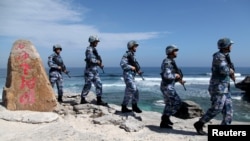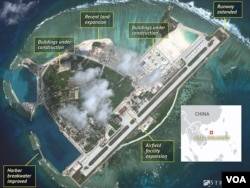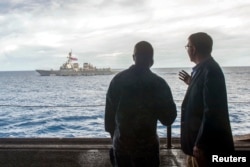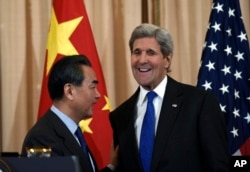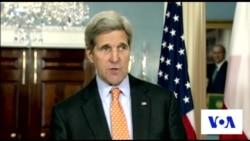China has again sent fighter jets to a disputed island where earlier this month it redeployed surface-to-air missiles and appears to be building a sophisticated radar system, according to U.S. officials.
Fewer than 10 jets – a combination of Shenyan J-11 and Xian JH-7 aircraft – have been spotted on Woody Island in the Paracel chain in the South China Sea, officials in Washington, who spoke on condition they not be named, told reporters late Tuesday.
On Wednesday, Nina Hachigian, the U.S. ambassador to the Association of Southeast Asian Nations, told reporters, "We are very concerned that these actions are increasing tensions in the region and are counterproductive."
The fighter jet sightings follow the placement of HQ-9 surface-to-air missiles on the 210-hectare island, known in Chinese as Yongxing and called Phu Lam by Vietnam, which also claims it.
Analysts express more alarm about the construction of a high frequency radar facility on the island, 400 kilometers southeast of China's Hainan island.
Radar advantages
The radar would bolster Beijing's ability to monitor surface and air traffic in the tense waters and “along with the development of new runways and air defense capabilities, they speak to a long-term anti-access strategy by China – one that would see it establish effective control over the sea and airspace throughout the South China Sea," according to the Asia Maritime Transparency Initiative at the Center for Strategic and International Studies in Washington.
After Chinese state media last November published images of J-11 fighter jets on Woody Island, the U.S. Navy sailed a guided-missile destroyer past another contested island in the South China Sea and flew B-52 bombers and sailed another warship in the region for a “freedom of navigation” exercise.
"Our freedom of navigation operations are routine, they are lawful,” said Ambassador Hachigian, speaking from Jakarta on a conference call. “They're conducted in accordance with international law. We've conducted these operations around the globe since 1979, including in the South China Sea and the South China Sea cannot be an exception."
Such activities have prompted Chinese officials to blame the United States for increasing tensions.
Diplomats meet
China's Foreign Minister Wang Yi, visiting the U.S. State Department on Tuesday, said he hoped that such flights and patrols by U.S. forces near the contested islands would cease.
"Regrettably, there are missiles, fighter aircraft, guns, artillery and other things that have been placed in the South China Sea, and this is of great concern to everyone who transits and relies on the South China Sea for peaceful trade, commerce and use," U.S. Secretary of State John Kerry, standing alongside Yi, told reporters.
Kerry said, however, not only China but Vietnam and others were also responsible for creating an “escalatory cycle” of reclamation and militarization in the disputed waters.
Earlier Tuesday, the head of the U.S. military’s Pacific Command, in testimony before the Senate Armed Services Committee, was less diplomatic, bluntly blaming Beijing for “clearly militarizing” the South China Sea.
"You’d have to believe in a flat Earth to believe otherwise," Admiral Harry Harris told senators.
Asked by lawmakers about the strategic goal of China's military buildup in the region, Harris replied: "I believe China seeks hegemony in East Asia."
WATCH: U.S. Secretary of State John Kerry criticizes China militarization of South China Sea island




